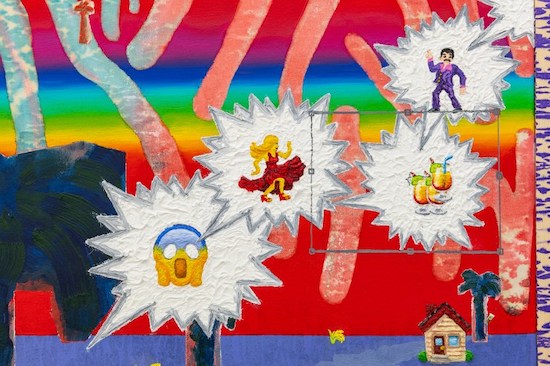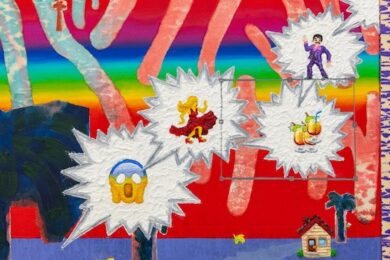The painting depicts a landscape on a stormy day. Mountains like jagged incisors. A line of trees receding into the distance. A lake. Sky. Rainclouds. But also: a giant hiking boot, absurdly outsized compared to the scale of the scene presented, lurching into the frame from the bottom left. A cartoonish ladybug climbing one of the peaks, almost equal to it in stature. A zombie’s head poking out from behind the lake. Something like a snake or maybe the Loch Ness monster, all s-curves in vivid green, a pink tongue flicked out, incongruously circumnavigating the foothills.
The storm clouds are not storm clouds but merely the icon of a storm cloud, like on a weatherman’s board. The sky is a strange smudge of bright orange. Crudely drawn ticks and a bright red sun litter the image like so much visual detritus. There are random squiggles and erasures. Elements of close filigreed detail and life-like shading – the rocky face of the mountain and greenery creeping it up it – and then frank, slapped on flatness. The lake simply a solid blue polygon.
And up in the sky, positively dominating the frame, an enormous grey-sleeved yellow hand holding aloft a smartphone, upon whose screen, a garish, grinning mouth. Say cheese!
The work is titled #worldwanderer – a tag that, if googled, will throw up countless pages on Instagram and Twitter bearing photos of sun-kissed shorelines, train windows wistfully gazed out of, and crystal clear blue mountain lakes, mountain lakes not a million miles away from the scene presented here. But it also bears a title that the formatting of this website, or at least my rudimentary IT skills, prevent me from writing here: an emoji icon of that same grey-sleeved iPhone-bearing hand, taking a photo of –– the world? This idyllic alpine scene? No. Of the painter herself behind the brush – or the viewer in the gallery, perhaps, pulling you into the frame and forcing you into complicity with its digital remaking of the world.
Hell Gette is an artist born in Karabulak in Kazakhstan, but currently based in Munich, Germany. She is a graduate of that city’s Academy of Fine Arts, where she studied with Markus Oehlen and her work shares with her former teacher a certain delirium, an almost manic, psychedelic sense of colour and clamour; a playful, teasing relationship with art history; a kind of gleeful rapprochement with low culture, poor taste, and bad painting (or should that be #badpainting?). In the past, her work has drawn on Netflix shows and console games. Her subjects tend to be stuff that is ubiquitous, but oddly invisible, beyond the margins of art history – albeit explored in a manner that is steeped in it.

The six canvases currently on show at Annka Kultys – five more-or-less standalone paintings and a diptych – are part of a series that Gette dubs Landscape 3.0, what she calls a “ping-pong between digital and analogue”, a process of iterated remediation the physical and the virtual. Images of landscapes are photographed and digitised then crudely overpainted with the rough-and-ready tools of primitive consumer-grade image manipulation software like Paint, all thick crayon-y smears and gradient fills, sections cut and enlarged and repeated or overlaid on top of themselves, often with the six-point net of the digital cutting tool left in, a six-point grid of straight grey lines and box-anchors at the corners and midpoints to be clicked and dragged. Emojis and clipart are pasted on willy nilly, with abandon. This now-thoroughly digital image is then re-painted in traditional oil paints, often in a thick impasto. Sections of canvas physically shopped and collaged. All in order to “deposit the landscape in a sort of intermediate world” and “tell stories within this intermediate world”.
There is a constant back and forth here between online and off, the real and its representation, revealing and concealing, original and repetition, hand-wrought and machine-made, flatness and volume. In places, the paint is laid on so thick that it bulges out of the canvas. There is an icecream emoji built out of thick swirls of paint that positively invites the viewer to lean in and lick. That ladybird in #worldwanderer is at least as three-dimensional as any real ladybird.
Gette’s process has a kind of repeatability – of icons, shapes, motifs, and gestures – baked in. Sure enough, elements of #worldwanderer emerge in other canvases in the gallery. In the diptych #filter and #nofilter, the mountains have been reduced to a series of geometric shapes, so many superimposed triangles of impossibly straight sides. The lake is now closer, and has acquired a kind of gesture towards higher definition. It is as though we have moved deeper into this landscape of pixels, levelled up in this surreal arcade game.

Between these two works there is a sort of reflection, the one the other’s mirror world or evil twin. Teetering piles of cash and ice cream emojis in the former have become equally precarious piles of fag ends and a poo emoji, occupying the same place in the picture frame. No/filter, here, does not so much imply the reality and its idealised representation or the truth and the lie you tell about it, but rather two different genres, the same fantasy as seen through two different #moods.
But there is something of the real here. Somehow, these are real landscapes – at least, as real as you can get these days. I am reminded of something I saw outside a mountain cafe in the Swiss alps once: a sort of billboard, about head-high, with a convenient rectangle cut out of it to frame (what someone had decided was) the best view over the surrounding peaks, just perfectly aligned for you to take your picture or frame yourself against the stunning backdrop – with a few suggestions for hashtags you could append to boot. The world has been remodelled to suit your Instagram feed.
And so, too, have you. As the tall y-axis and shorter x-axis of these paintings suggest, these images are not just landscapes but also portraits – depictions of our digital selves. Or perhaps the truth of Landscape 3.0 is that, today, all landscapes become portraits. We capture the picturesque scenery only in order to depict ourselves.
In an interview with Jürgen Dehm (who also curated this show) for Artfridge, back in January, Gette described her childhood as a “a wild child, who spent much time outdoors in nature to experience ‘adventures’.” Hell Gette’s paintings feel like an adventure in themselves: vivid and unruly and rambunctious.
Hell Gette ## is at Annka Kultys Gallery, London, by appointment only, until 18 July 2020



